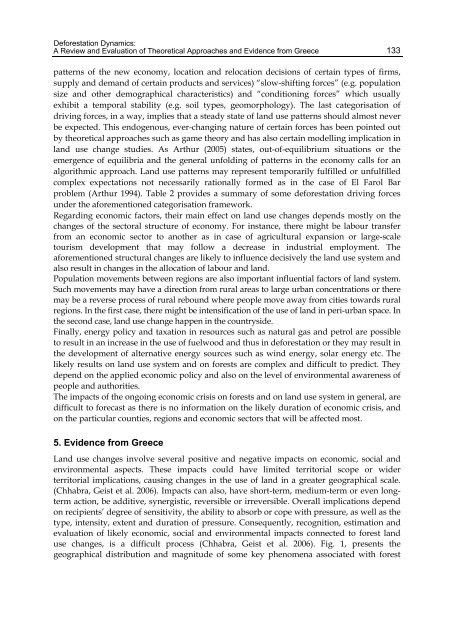DEFORESTATION AROUND THE WORLD - India Environment Portal
DEFORESTATION AROUND THE WORLD - India Environment Portal
DEFORESTATION AROUND THE WORLD - India Environment Portal
You also want an ePaper? Increase the reach of your titles
YUMPU automatically turns print PDFs into web optimized ePapers that Google loves.
Deforestation Dynamics:<br />
A Review and Evaluation of Theoretical Approaches and Evidence from Greece<br />
patterns of the new economy, location and relocation decisions of certain types of firms,<br />
supply and demand of certain products and services) “slow-shifting forces” (e.g. population<br />
size and other demographical characteristics) and “conditioning forces” which usually<br />
exhibit a temporal stability (e.g. soil types, geomorphology). The last categorisation of<br />
driving forces, in a way, implies that a steady state of land use patterns should almost never<br />
be expected. This endogenous, ever-changing nature of certain forces has been pointed out<br />
by theoretical approaches such as game theory and has also certain modelling implication in<br />
land use change studies. As Arthur (2005) states, out-of-equilibrium situations or the<br />
emergence of equilibria and the general unfolding of patterns in the economy calls for an<br />
algorithmic approach. Land use patterns may represent temporarily fulfilled or unfulfilled<br />
complex expectations not necessarily rationally formed as in the case of El Farol Bar<br />
problem (Arthur 1994). Table 2 provides a summary of some deforestation driving forces<br />
under the aforementioned categorisation framework.<br />
Regarding economic factors, their main effect on land use changes depends mostly on the<br />
changes of the sectoral structure of economy. For instance, there might be labour transfer<br />
from an economic sector to another as in case of agricultural expansion or large-scale<br />
tourism development that may follow a decrease in industrial employment. The<br />
aforementioned structural changes are likely to influence decisively the land use system and<br />
also result in changes in the allocation of labour and land.<br />
Population movements between regions are also important influential factors of land system.<br />
Such movements may have a direction from rural areas to large urban concentrations or there<br />
may be a reverse process of rural rebound where people move away from cities towards rural<br />
regions. In the first case, there might be intensification of the use of land in peri-urban space. In<br />
the second case, land use change happen in the countryside.<br />
Finally, energy policy and taxation in resources such as natural gas and petrol are possible<br />
to result in an increase in the use of fuelwood and thus in deforestation or they may result in<br />
the development of alternative energy sources such as wind energy, solar energy etc. The<br />
likely results on land use system and on forests are complex and difficult to predict. They<br />
depend on the applied economic policy and also on the level of environmental awareness of<br />
people and authorities.<br />
The impacts of the ongoing economic crisis on forests and on land use system in general, are<br />
difficult to forecast as there is no information on the likely duration of economic crisis, and<br />
on the particular counties, regions and economic sectors that will be affected most.<br />
5. Evidence from Greece<br />
Land use changes involve several positive and negative impacts on economic, social and<br />
environmental aspects. These impacts could have limited territorial scope or wider<br />
territorial implications, causing changes in the use of land in a greater geographical scale.<br />
(Chhabra, Geist et al. 2006). Impacts can also, have short-term, medium-term or even longterm<br />
action, be additive, synergistic, reversible or irreversible. Overall implications depend<br />
on recipients’ degree of sensitivity, the ability to absorb or cope with pressure, as well as the<br />
type, intensity, extent and duration of pressure. Consequently, recognition, estimation and<br />
evaluation of likely economic, social and environmental impacts connected to forest land<br />
use changes, is a difficult process (Chhabra, Geist et al. 2006). Fig. 1, presents the<br />
geographical distribution and magnitude of some key phenomena associated with forest<br />
133

















